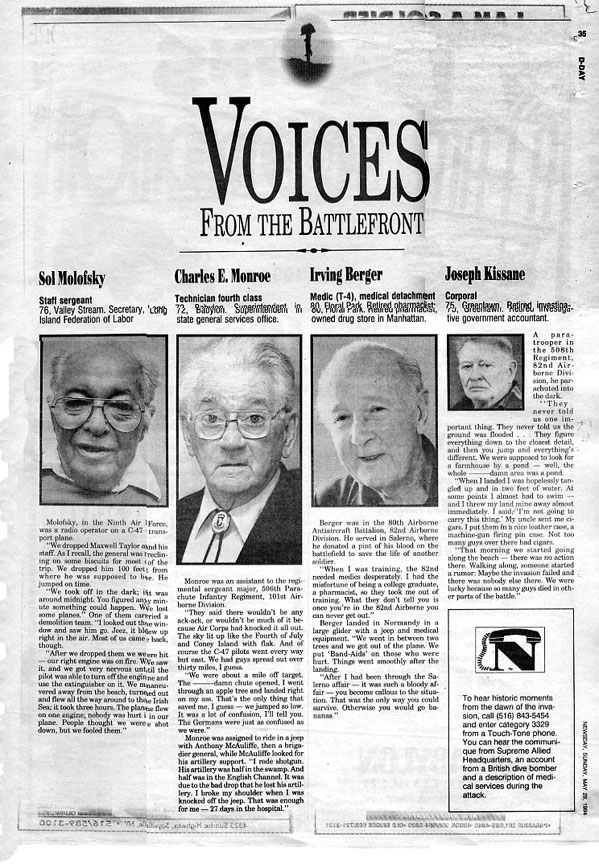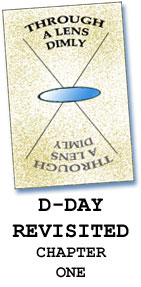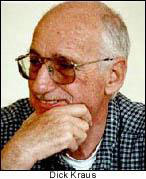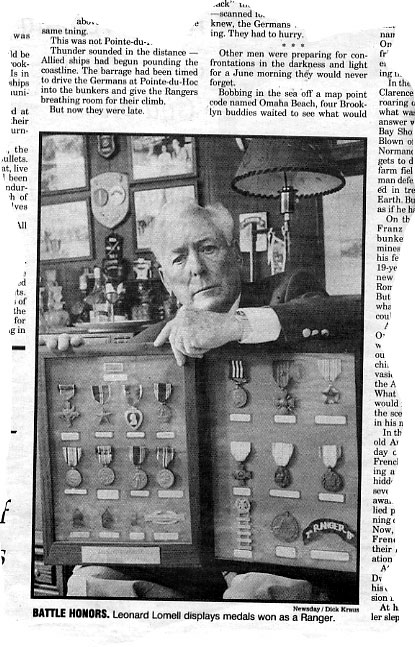PROLOGUE
I was twelve years old when the radio announced that the Allies had
launched the long awaited invasion of Europe that would ultimately
lead to victory and the end of World War II. That day was June 6,
1944 and would come to be known as D-Day.
This June will be the 60th anniversary of that historic event.
I beg your indulgence as I begin the story, about one of the greatest
assignments of my long career as a newspaper photographer.
D-DAY REVISITED
By Dick Kraus
Newsday
Staff Photographer (retired)
I always had difficulty sleeping on planes and this long flight proved
no different. We had left JFK Airport around midnight on a non-stop
flight that would take us to Frankfurt, Germany. I had the window
seat. Dozing in the seat next to me was Jim Kindall, the reporter
with whom I was working.
I turned and gazed out of the window. We had been flying for hours.
For exactly how long, I had no clue. I had lost track of time as
we passed through one time zone after another while we sped eastward
to greet a new sunrise. As I looked down through the stygian night,
expecting to see nothing more than the darkness that was the North
Atlantic, I was surprised to see lights far below. At first I thought
they might be the navigation lights of some fleet of fishing trawlers
working the ocean far beneath me. But, I noticed that there were
regular patterns to the lights and assumed that we must be over land
now, and passing some small villages on the coast of Great Britain.
That would mean that we would be landing in an hour or so.
Six weeks earlier, I had returned to the office after covering several
forgettable, mundane assignments. Sandy, the Photo Department Den
Mother/Secretary, stopped by the door of the color processing room
and said, “Jim wants to see you in his office as soon as you
have a chance.”
Hmmm. What could that be about? Jim had been the Chief Photo Editor
at Newsday for a number of years. He and I had different opinions
on newspaper photography and our working relationship could be said
to have been cordial but nothing more. I was obviously not his first
choice among the staff of some thirty-odd photographers to be awarded
any plum assignments. But, he was the head of the department, so
I got my film started in the processor and went to see him.
His back was toward me as he worked at his computer. I knocked on
the frame of his open door. “You wanted to see me, Jim?”
“
Oh, yes Dick. Come on in.” He turned to face me. “I have
a project that I want you to work on.”
Oh, Jeez. What could this be about? Projects were normally
sought after assignments that usually went to his preferred staffers.
If he were giving one to me, it would probably be something that
required an obscene amount of headshots. Many of our projects were
all about headshots. They were usually investigative pieces that
involved making head shots of the people involved. And, since so
many of them were reluctant to be photographed, it would mean staking
them out and playing paparazzi. I hated that. But, Jim invited me
to sit down and I listened as he explained what this project entailed.
Newsday was planning a huge special section to commemorate the 50th
Anniversary of D-Day, which would occur in less than a year. It was
then early November 1993 and he wanted me to collaborate with James
Kindall, one of Newsday’s top feature writers. Kindall would
be interviewing American Veterans who survived the landings and the
war, and documenting their recollections of that historic event.
Mostly we would interview vets who lived on Long Island, but some
would require a bit of travel.
Oh crap!! Just as I thought. Headshots.
He went on. Kindall and I would travel to Germany to interview German
veterans who had fought against our troops and attempt to prevent
them from landing in Normandy.
Hold on a second. Did he say Germany? Was I going to Germany to do
this? Or would he say that I was only doing the local angle and they
would get the wire services to shoot the German part of the story?
No, he was really saying that not only would I go to Germany, but
I would travel with Kindall to France where we would talk with survivors
of the French Resistance and also photograph the locations in Normandy
where those Allied landings took place.
We were to spend a week in Germany and then a week in Normandy. After
that, there would be more work locally. As Kindall wrote his story,
we would get together and wed the art with the words. I was told
that I would play a major role in putting out this special section.
My boss said that I would collaborate with the Art Director who was
to do the layout. Plus, Kindall and I would return to France just
prior to the actual D-Day Anniversary to file daily stories about
the preparations as well as the ceremonies on June 6th. All of this
was unprecedented and I couldn’t believe that I had been chosen
to do this great project.
© Newsday
This is the wrap around front
and back page of the special D-Day issue put out by
Newsday to commemorate the 50th Anniversary. The photo
was from the archives and was shot on June 6, 1944
as American
troops waded ashore in Normandy. My copy is
a bit faded and yellowed with age. |
|
As soon as
I finished with The Chief Photo Editor, I went out to the Newsroom
to find Jim Kindall. I knew of him. I had read some
of his stuff. But, I had never met him. He did features and I did
mostly news. I asked around the room and was directed to Kindall’s
desk. I found him working his way through piles of paper on his
desk, which also contained open maps of Germany and France. Jim
was a good-looking
young man who had an intensity about him, which indicated to me
that he took his work seriously. That was encouraging and when
I introduced
myself, he greeted me warmly and said that he was familiar with
my work. I knew that he would be a pleasure to work with.
Kindall told me that he had spent the day on the phone to Germany,
trying to locate several of the German veterans whose names he
had been given. Some were deceased but there were several with
whom he
had made contact and he was able to set up interviews in the next
couple of weeks. He had marked their hometowns on the map and now
we made plans on how we would proceed once we got to Germany.
Our decision was to fly to Frankfurt on November 16th. We would
get a Eurail Pass and would take trains around Germany to get to
our
various interviews. This would take a week and then we would take
a train to Caen, France, which was the provincial capitol of Normandy,
and we would operate out of that city as we covered the battlefields
and the French interviews.
 |
Before
leaving for Europe, though, I would start photographing some
of the local American veterans. Kindall was to concentrate
his efforts on the main stories. Other reporters would do the
interviews with the local vets, some of whom would be categorized
under the heading of “Voices From The Battlefront.” I
would photograph most of them. Other members of the photo staff
would make those whom I couldn’t do because of time constraints. |
Kindall did
the first interview because it was a major part of the main story.
The noted author, Cornelius Ryan, had documented
this
particular incident in his book, “The Longest Day,” which
chronicled the D-Day invasion. It was later made into an epic
movie. This story pertained to a specially trained unit of the
US Army Rangers,
which was to land at the base of the steep cliffs that ran down
into the water at a place called Pointe du Hoc. The Rangers were
to shoot
rocket propelled ropes with grappling hooks attached, to the
top of the cliffs and then they would climb the ropes, all the
while
taking heavy fire from the German troops firing down on them
from the heights. Their mission was to secure the cliffs and
destroy the
battery of German 155 mm coastal guns that American Intelligence
had determined to be there. Those guns could play havoc on the
ships and landing craft as they discharged the troops on the
beaches below.
In his book, Ryan wrote that the mission was a failure that cost
many American lives, because when the Rangers finally got to
the top, they found that the 155’s in their emplacements were phonies.
The Americans had suffered many dead, only to find that the critical
guns weren’t guns at all.
Jim Kindall and I drove to New Jersey to interview one of the survivors
of that raid. Leonard Lomell was a highly decorated sergeant who
remembers the battle quite well. I photographed him with his medals
and as he spoke of that day, his voice was tinged with resentment
when Ryan’s account of that battle in “The Longest
Day” was brought up.
Lomell transported
us with him into the Hell of that furious raid as he detailed all
that had transpired. He talked of the brave comrades who fell under
the fusillade of bullets that rained down on them as they stepped
from their landing craft and ran for the temporary shelter afforded
by the overhanging cliff. He spoke of the difficulty of firing
those coils of rocket-propelled ropes to the top, many of which
bounced off and fell back onto the beach below. And then, of the
arduous hand over hand climb to the top, watching friends being
blasted from the ropes by enemy gunfire and falling hundreds of
feet into the ocean.
Len Lomell
made it to the top with a flesh wound in his side, and along with
a handful of brave survivors, secured the area. That’s when
he made the horrible discovery that the guns were phonies.
It is here that Lomell departs
from the account in the book. His voice rose as he tells us that Cornelius
Ryan
neglected to follow up on the Rangers’ actions after getting to the top
of Pointe du Hoc. It was then that Lomell and another G.I. went on a scouting
mission. After crawling on their bellies around one hedgerow after another
they came upon the real 155mm guns in a field about 200 yards further inland
from
the top of the cliff where they had landed. The two men couldn’t believe
their luck. Not only had they quickly located the reason for their mission,
but the guns were unmanned and unguarded. A few hundred yards further away
were the
German gunners. They were grouped around an officer and were apparently being
briefed about the Allied Invasion. They were oblivious to the Americans in
their midst.
Lomell crept to the
German guns and dropped thermite grenades in the gears of their
tracking mechanisms. The grenades were relatively silent and
went unnoticed by the Germans. The thermite burned at extremely
high temperatures and melted and fused the gears rendering the
guns, as Lomell put it, into huge paperweights, since they could
no longer be turned to bear on any targets. |
|
At least
the proud veteran was able to clear the record on the efficacy
of the raid at Pointe du Hoc as far as the readers
of Newsday were
concerned.
newspix@optonline.net




